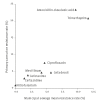Population-level surveillance of antibiotic resistance in Escherichia coli through sewage analysis
- PMID: 31530345
- PMCID: PMC6749774
- DOI: 10.2807/1560-7917.ES.2019.24.37.1800497
Population-level surveillance of antibiotic resistance in Escherichia coli through sewage analysis
Abstract
IntroductionThe occurrence of antibiotic resistance in faecal bacteria in sewage is likely to reflect the current local clinical resistance situation.AimThis observational study investigated the relationship between Escherichia coli resistance rates in sewage and clinical samples representing the same human populations.MethodsE. coli were isolated from eight hospital (n = 721 isolates) and six municipal (n = 531 isolates) sewage samples, over 1 year in Gothenburg, Sweden. An inexpensive broth screening method was validated against disk diffusion and applied to determine resistance against 11 antibiotics in sewage isolates. Resistance data on E. coli isolated from clinical samples from corresponding local hospital and primary care patients were collected during the same year and compared with those of the sewage isolates by linear regression.ResultsE. coli resistance rates derived from hospital sewage and hospital patients strongly correlated (r2 = 0.95 for urine and 0.89 for blood samples), as did resistance rates in E. coli from municipal sewage and primary care urine samples (r2 = 0.82). Resistance rates in hospital sewage isolates were close to those in hospital clinical isolates while resistance rates in municipal sewage isolates were about half of those measured in primary care isolates. Resistance rates in municipal sewage isolates were more stable between sampling occasions than those from hospital sewage.ConclusionOur findings provide support for development of a low-cost, sewage-based surveillance system for antibiotic resistance in E. coli, which could complement current monitoring systems and provide clinically relevant antibiotic resistance data for countries and regions where surveillance is lacking.
Keywords: Escherichia coli; antibiotic resistance; antimicrobial resistance; sewage; surveillance; wastewater.
Conflict of interest statement
Figures


References
-
- World Health Organization (WHO). Global priority list of antibiotic-resistant bacteria to guide research, discovery, and development of new antibiotics. Geneva: WHO; 2017.
-
- World Health Organization (WHO). Worldwide country situation analysis: response to antimicrobial resistance. Geneva: WHO; 2015.
-
- World Health Organization (WHO). Global antimicrobial resistance surveillance system (GLASS) report. Geneva: WHO; 2018.
MeSH terms
Substances
LinkOut - more resources
Full Text Sources
Medical
Molecular Biology Databases
